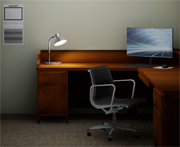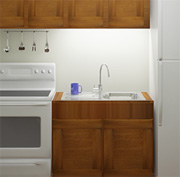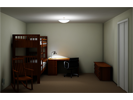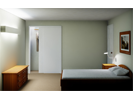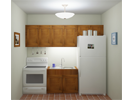
Task Lighting
Task lighting provides increased light for specific tasks in a room that may already have some ambient light. Task lighting is especially useful for seeing small objects or objects of low contrast. For example, a person who is sewing would need extra light to easily see fine details. Task lighting can also provide increased light for tasks that require accuracy, such as reading directions on a bottle of medicine or chopping vegetables in the kitchen. Task lighting is also useful for workspaces, such as a workbench or woodshop in the garage, or a space used for arts and crafts.
Desk lamps provide adjustable task lighting that can be aimed in a specific direction, for demanding visual tasks such as reading and writing. Plug-in table and floor lamps are also commonly used to provide task lighting for reading.
Wall-mounted adjustable arm lamps, also known as swing-arm lamps, are often located in the bedroom, near the bedside, and are commonly used as task lighting for reading in the evening. These fixtures can be positioned to direct light onto reading material and avoid glare. Switch the fixture separately from other fixtures in the room, and locate the switch so that it is accessible from the bed. Install the fixture above the headboard to minimize shadows. This type of fixture may be appropriate for a child's bedroom to avoid floor and table lamps, which can be tipped over.
Always consider the tasks that will be performed in a room before designing the lighting. Plan for multiple uses of rooms, and for various arrangements of furniture. Remember that as people age, they need more light for critical tasks.
Example Patterns
